Data Brief 2020-031 | December 11, 2020 | Written and compiled by Leila Gonzales and Christopher Keane, AGI
Download Data Brief
COVID-19 Impacts on Geoscience Academic Instructional Environments through November 2020
This data brief provides an update on the changes in geoscience
academic instructional environments that have resulted from the COVID-19
pandemic. While the percentage of departments offering in-person
instruction for courses and labs increased through the Fall, by October,
these percentages began to decline. Online formats continue to be the
prevailing instructional format for courses and labs for the time being,
while online and local site modes are most common for field instruction
and activities.
Academic courses
For course formats, 81% of departments were using online instruction in
November 2020. Use of in-person instruction increased from 44% in August
to 49% in October, thereafter declining to 34% in November, while the
percentage of departments using hybrid course formats, such as
flipped/blended or HyFlex formats, followed a similar trend - increasing
from 46% of departments in August to 49% in September, thereafter
declining to 39% in November. One-fifth of departments offered both
flipped/blended and HyFlex course formats from August through October,
and this percentage declined to 13% in November.
We asked faculty and students about their preferences for instructional
formats for introductory courses, undergraduate courses, and upper
division courses. Faculty preferred in-person instruction for all
course categories over all other instructional formats with
flipped/blended course formats that provide scheduled times for
in-person and online instruction as their second preferred format. The
least preferred format by faculty for all courses was the HyFlex format
where students can choose to attend either in-person or online class
sessions.
The top two preferred formats by students were in-person instruction and
synchronous online instruction, with in-person formats being ranked
above synchronous online formats for undergraduate or upper division
courses. Instructional formats that ranked 5th or 6th (i.e., the least
preferred formats) included in-person formats for introductory courses
and asynchronous online formats for undergraduate and upper division
courses.

DB_2020-031 chart01 Course instructional formats (Credit: AGI; data from AGI's Geoscience COVID-19 Survey)
AGI
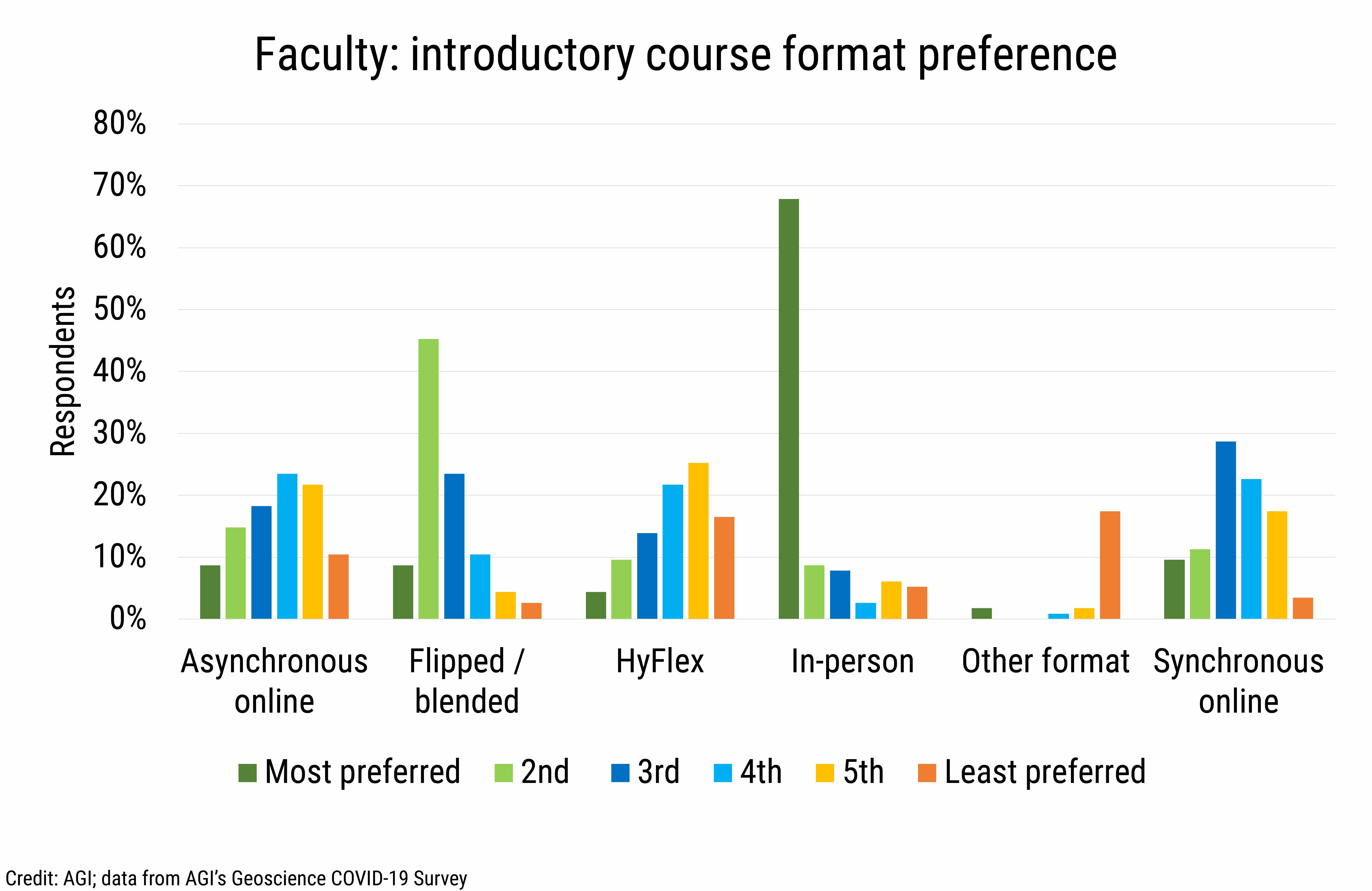
DB_2020-031 chart02 Faculty introductory course format preference (Credit: AGI; data from AGI's Geoscience COVID-19 Survey)
AGI

DB_2020-031 chart03 Faculty undergraduate course format preference (Credit: AGI; data from AGI's Geoscience COVID-19 Survey)
AGI

DB_2020-031 chart04 Faculty upper division course format preference (Credit: AGI; data from AGI's Geoscience COVID-19 Survey)
AGI
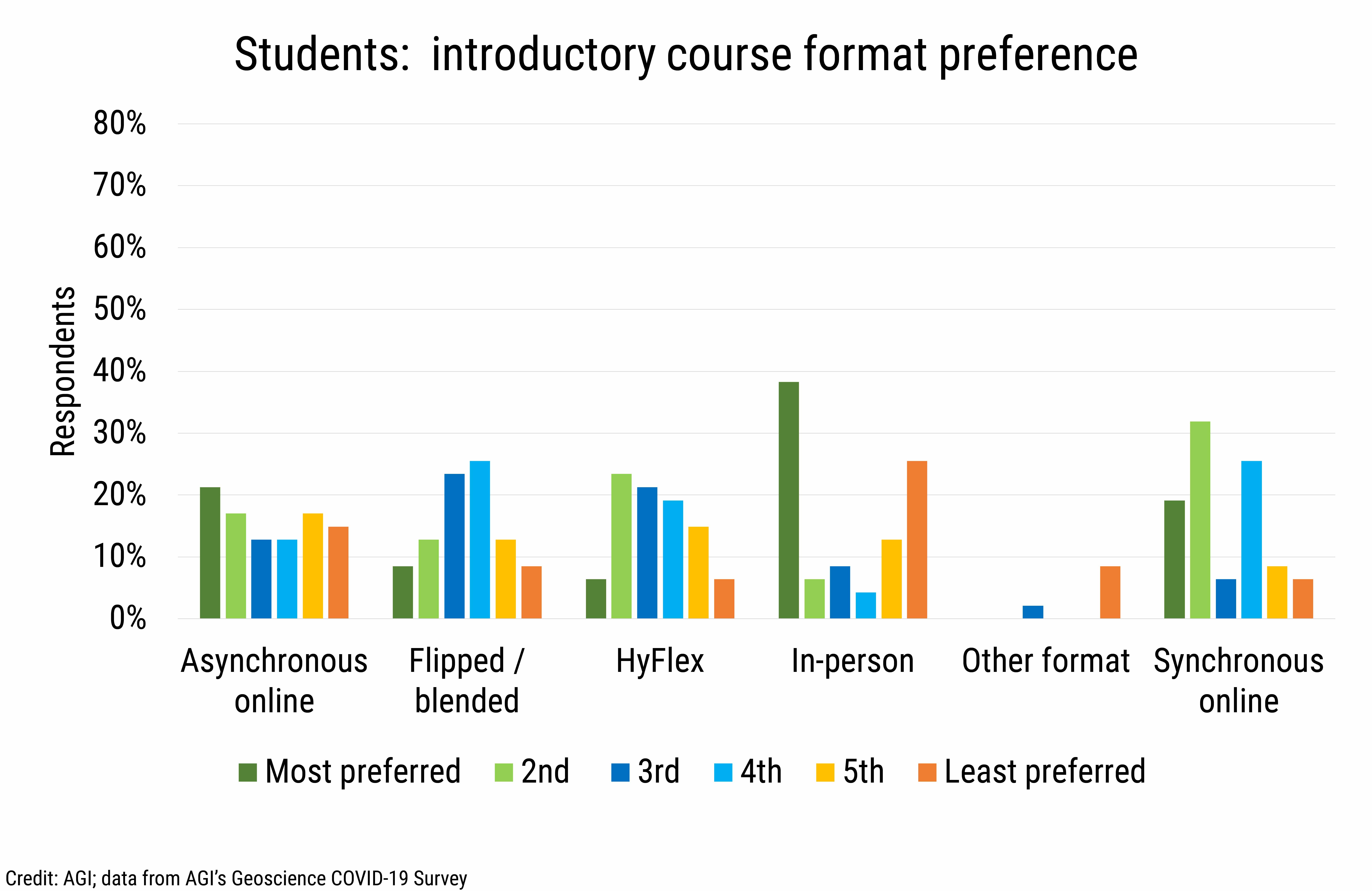
DB_2020-031 chart05 Students introductory course format preference (Credit: AGI; data from AGI's Geoscience COVID-19 Survey)
AGI
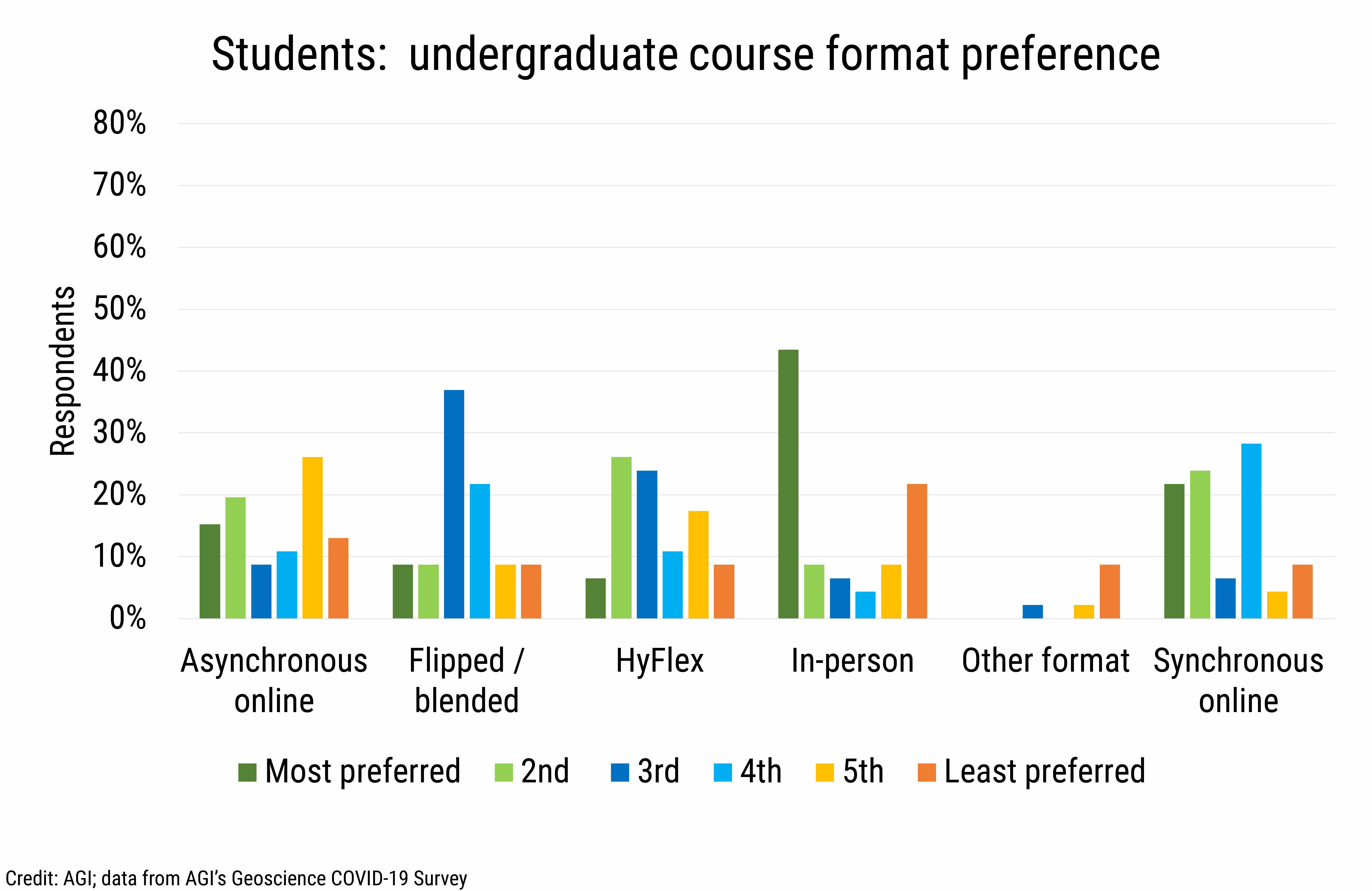
DB_2020-031 chart06 Students undergraduate course format preference (Credit: AGI; data from AGI's Geoscience COVID-19 Survey)
AGI
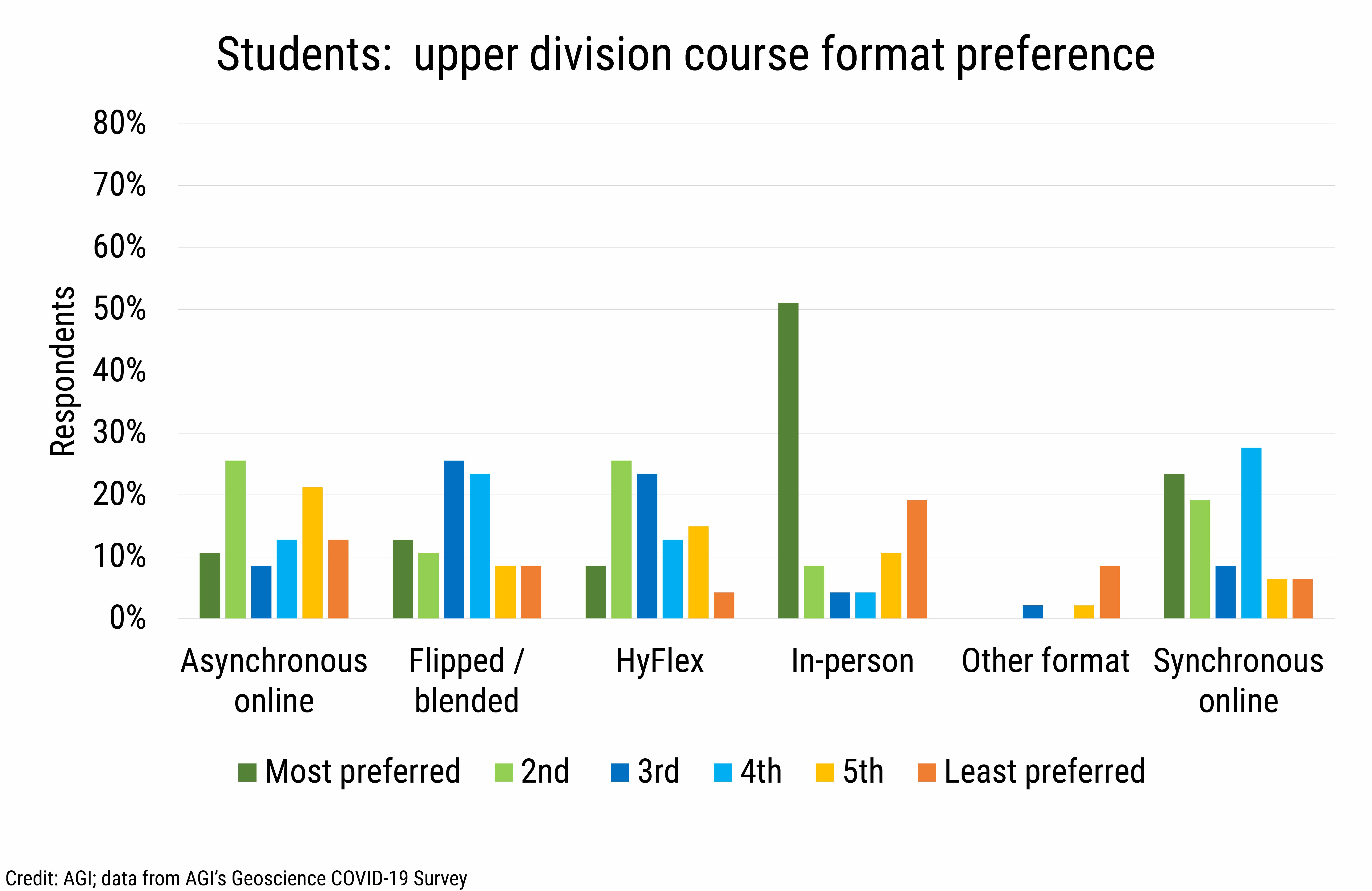
DB_2020-031 chart07 Students upper division course format preference (Credit: AGI; data from AGI's Geoscience COVID-19 Survey)
AGI
Lab sections and classes
While virtual labs continue to be the most common format for lab
sections and classes, throughout the summer, an increasing percentage of
departments offered in-person instruction. The percentage of departments
offering in-person labs peaked at 58% in August, decreasing to 48% by
November. Since June, the percentage of departments using a combination
of formats for lab sections and classes increased from 47% to 64% by
November. In November, 37% of departments incorporated in-person lab
instruction, while 27% of departments used a mix of only online (i.e.,
virtual or computational) formats and at-home activities.
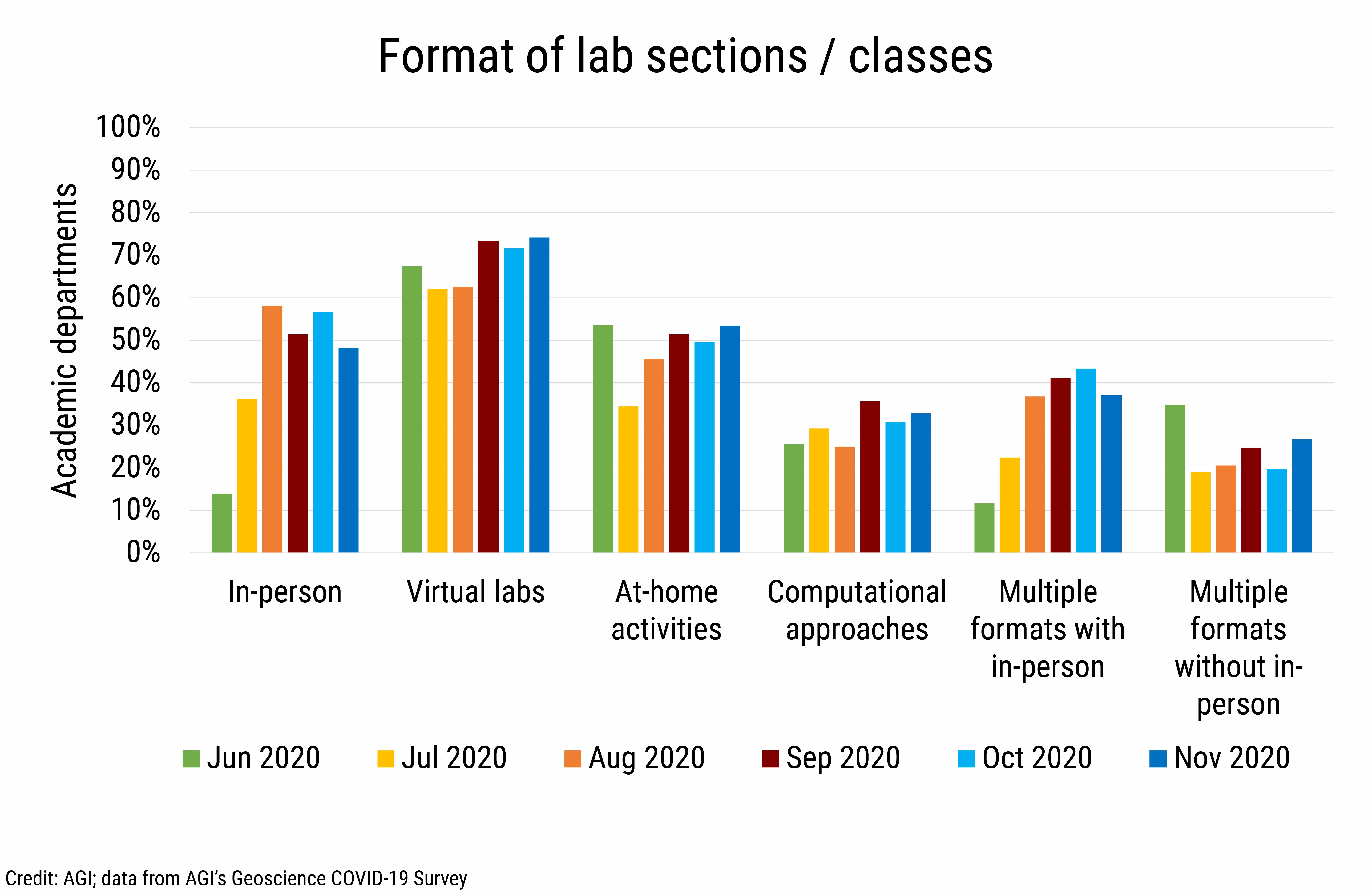
DB_2020-031 chart08 Format of lab sections classes (Credit: AGI; data from AGI's Geoscience COVID-19 Survey)
AGI
Are virtual labs here to stay?
With most departments using virtual formats for lab sections and
classes, in September we inquired about how virtual labs would be
integrated into teaching strategies over the long-term. Two-thirds of
departments indicated that they planned to continue using virtual labs
for the long-term, while one-quarter of departments indicated they had
no plans to continue virtual lab formats. Only 9% of departments that
planned to continue using virtual labs intended to use virtual labs as a
replacement for in-person lab sections or classes. Most departments
indicated plans for incorporating virtual labs into existing courses as
supplemental activities, and several departments noted how virtual labs
were useful in cases where students were unable to attend in-person lab
sections or in cases where in-person instruction was not feasible.
Field instruction and activities
Since June, field instruction and activities changed from predominantly
virtual field experiences to an increasing percentage of departments
offering local field activities. In addition, similar to lab
instructional formats, departments have been increasingly using a
combination of formats for field activities and instruction. Some
respondents indicated using local field experiences included self-guided
local investigations and local in-person instruction with a small number
of students per instructional cohort.
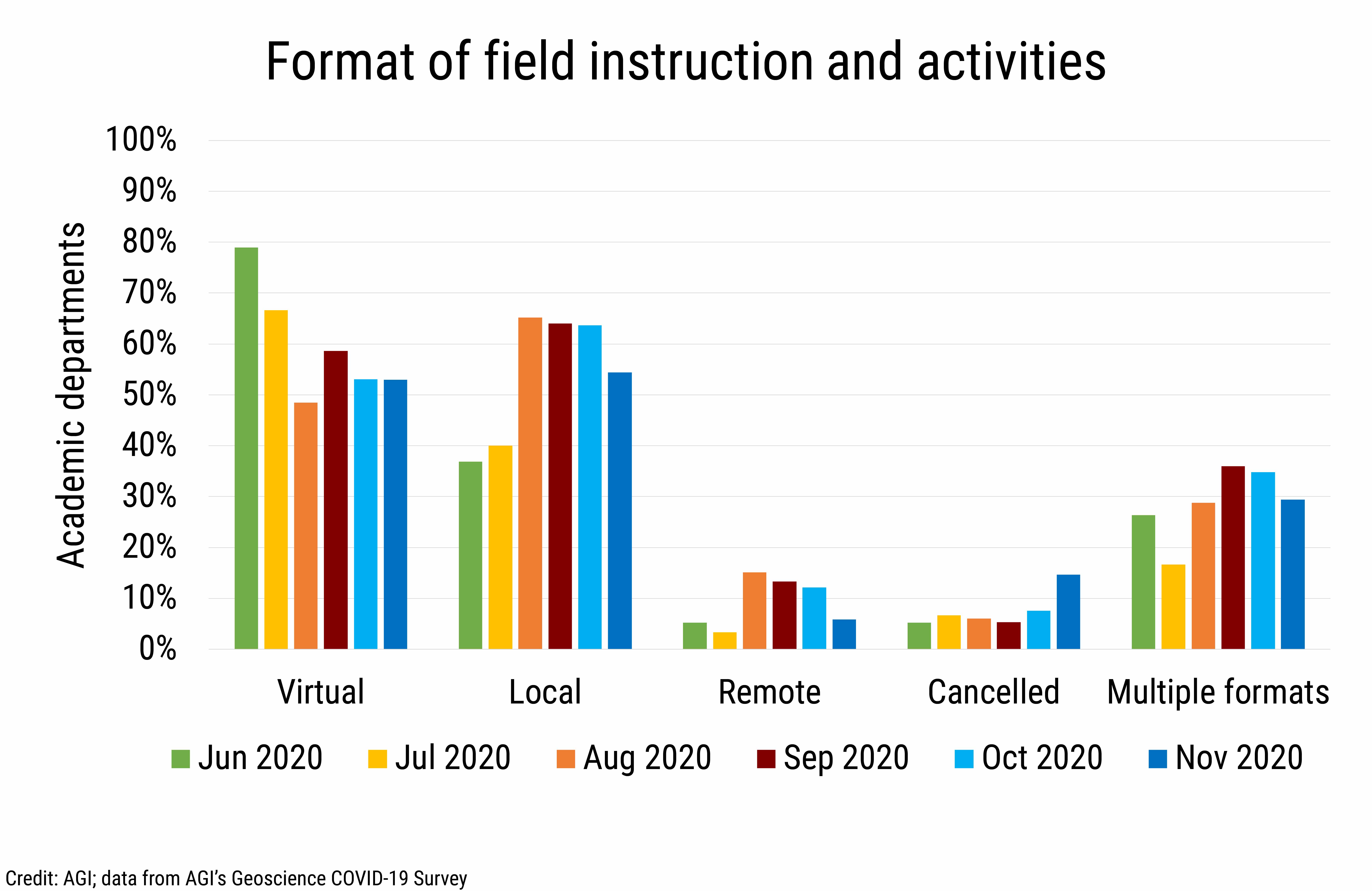
DB_2020-031 chart09 Format of field instruction and activities (Credit: AGI; data from AGI's Geoscience COVID-19 Survey)
AGI
Are virtual field experiences here to stay?
With over half of departments using virtual instruction for field
activities, in September we inquired about how virtual field experiences
would be integrated into teaching strategies over the long-term.
Three-quarters of departments indicated that they planned to continue
using virtual field experiences for the long-term, while one-fifth of
departments indicated they had no plans to continue virtual instruction.
Plans for integration into existing curricula included using virtual
field experiences as part of introductory courses or as supplemental
activities in other courses. Many departments mentioned the benefits of
virtual field experiences in increasing accessibility, especially for
students who are not able to attend in-person field activities, whether
because of disability, financial hardship, illness, or scheduling
issues. Other departments noted the usefulness of virtual field
experiences for cases where in-person instruction was not feasible, such
as during the current pandemic, due to an instructor being ill, or
because of inclement weather. In addition, some departments mentioned
plans to use virtual field experiences as a complement to in-person
field activities, such as for preparation for and post-analysis of
in-person field activities. In addition, many departments, even those
with plans for long-term use of virtual field experiences, acknowledged
the importance of in-person field activities and the hands-on experience
students gain through such experiences.
Math and computer programming competency gaps
In November, 40% of faculty indicated they were incorporating more math
and programming skills in their virtual labs and/or field activities. Of
those faculty, most said that they found their students lacking the
necessary math and/or programming skills required for these activities.
Specific competency gaps included lack of proficiency with basic
algebra, data management skills for cleaning and manipulating data,
making and interpreting graphs, using Excel for basic data manipulation
and analysis, and a lack of understanding for how to use programming to
solve project tasks.
Teaching and Learning Environments
In September, we asked survey participants about their work-at-home and
remote learning environments and inquired about their productivity
levels and challenges with at-home learning and teaching. The majority
of faculty and students reported using a dedicated workspace for their
working and learning activities (81% and 59% respectively). While 52% of
students reported using a shared workspace for their learning
activities, such as common areas shared with other people or using
spaces that also had other uses as well, such as the kitchen table, only
28% of faculty reported the same. More faculty than students reported
upgrading their internet connections (30% vs. 19%), obtaining new
hardware (58% vs. 41%) and additional supplies, such as textbooks,
school supplies, etc. (39% vs. 11%). In addition, 6% of faculty reported
purchasing additional office furniture.
Most faculty members reported being moderately to extremely productive
with teaching activities (72%) and with the ability to focus on work
activities (68%), and 47% of faculty reported being moderately to
extremely productive with meetings. Faculty reported being least
productive with research activities and collaboration with colleagues.
Most students (61%) reported being moderately to extremely productive
with faculty and adviser meetings, and 36% of students reported being
moderately to extremely productive with the ability to focus on class
work. Students reported being least productive with study time, with 46%
of students reporting being not productive or slightly productive, and
39% of students reported being not productive or slightly productive
with collaborating with other students on research projects.
Faculty and students reported using a variety of communication
technology platforms for teaching and learning. Over 90% of faculty and
students reporting using Zoom, and less than half of faculty and
students reporting using other platforms. More faculty than students
reported using Microsoft Teams, GoToMeeting, WebEx, and Skype, and more
students than faculty reported using Google Meet, WhatsApp, and Slack.
Other platforms mentioned included Asana, Brightspace, Design2Learn,
Collaborate Ultra, Discord, Piazza, Google Docs, Learning Symposium,
Moodle, Panopto, Sakai, Schoology, Big Blue Button, and Top Hat.
When asked about needing to be physically present at the office, 54% of
faculty reported it was either not necessary or slightly necessary. Only
25% of faculty reported that their physical presence at the office was
moderately to extremely necessary.
When asked about their current proficiency with virtual platform
features relative to last year, the majority of faculty and students
reported being moderately to extremely proficient with using the
platforms, presenting and collaborating virtually, and using the
platform tools for collaborative work. Students reported higher levels
of proficiency than faculty across all categories.
Challenges mentioned by faculty in working from home centered around
several key topics: how their work-at-home environment is set up,
sharing their workspace with other members of their household, lack of
childcare and interruptions from other members of their household,
increased workloads due to providing both online and in-person
instruction, lack of work-life balance, facility restrictions impacting
research productivity, students needing more attention and interaction,
lack of IT and institutional support, and issues with online teaching
and student interactions.
Challenges mentioned by students about their remote learning
environment centered around the ability to stay focused and motivated to
complete coursework, with how their home-based learning environment was
set up, and issues with interruptions and distractions from sharing the
space they use for learning with other members of their household.
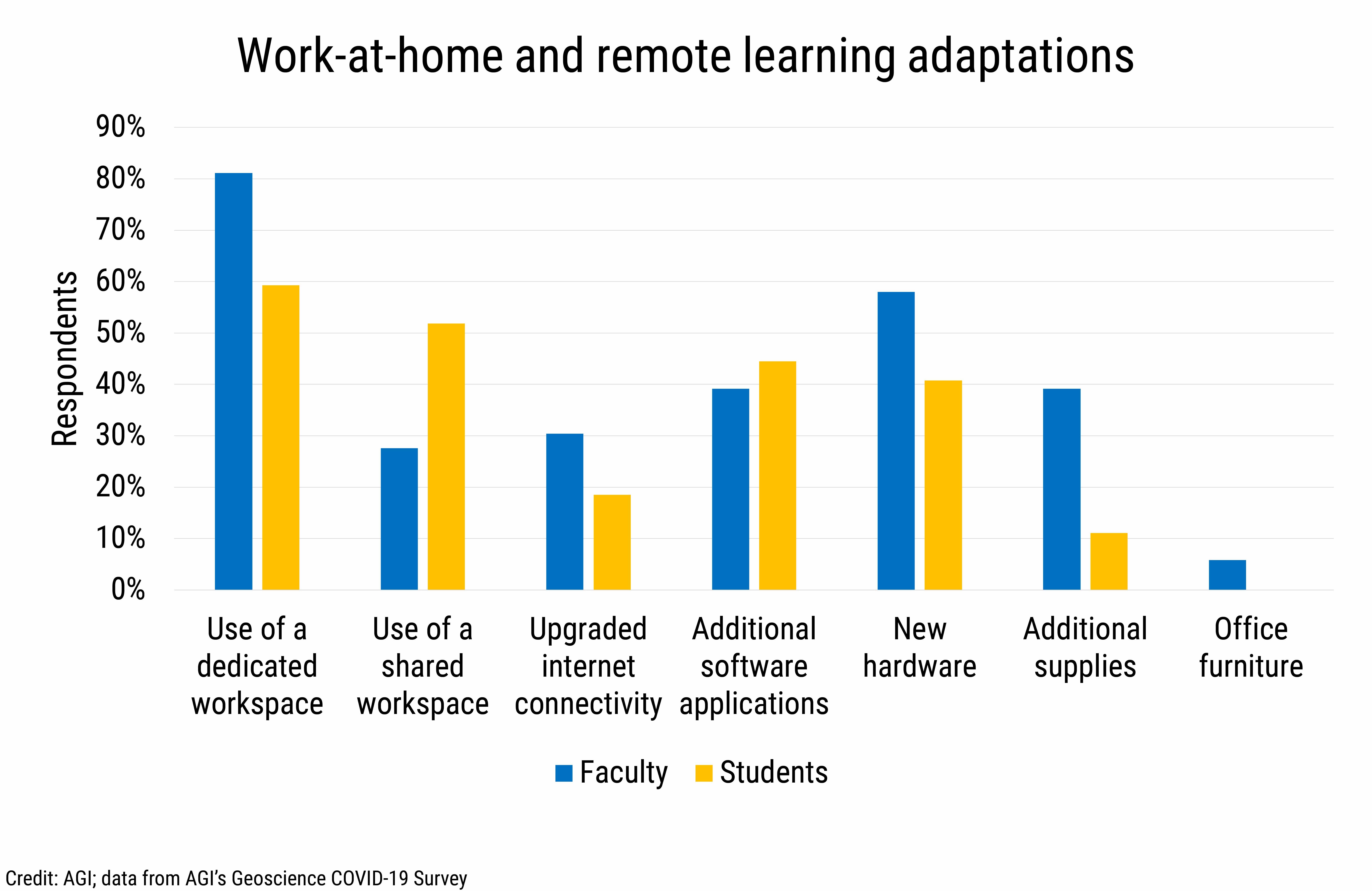
DB_2020-031 chart10 Work-at-home and remote learning adaptations (Credit: AGI; data from AGI's Geoscience COVID-19 Survey)
AGI

DB_2020-031 chart11 Faculty productivity level working from home compared to working in the office (Credit: AGI; data from AGI's Geoscience COVID-19 Survey)
AGI

DB_2020-031 chart12 Students productivity level remote learning compared to in-person learning (Credit: AGI; data from AGI's Geoscience COVID-19 Survey)
AGI
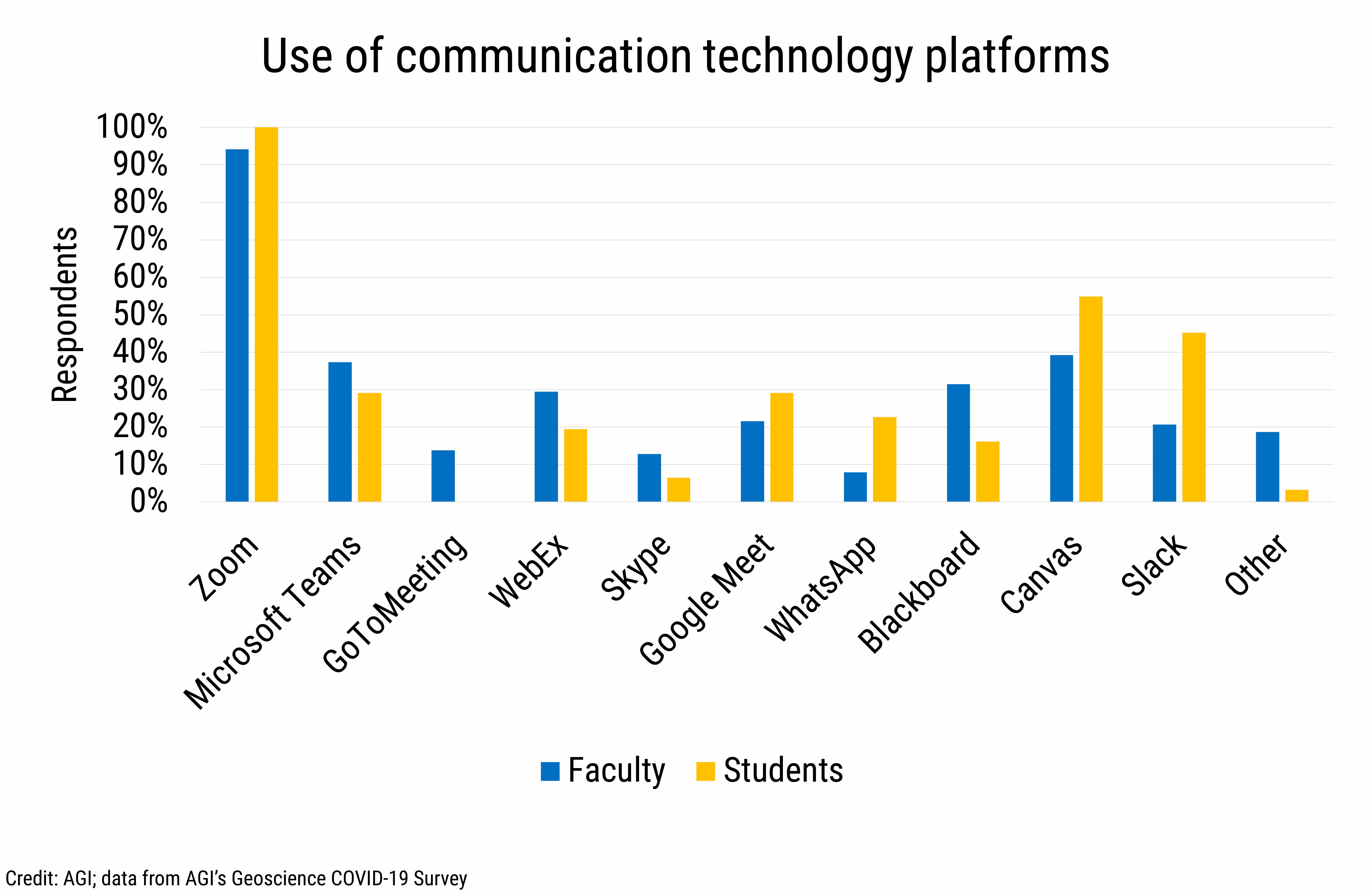
DB_2020-031 chart13 Use of communciation technology platforms (Credit: AGI; data from AGI's Geoscience COVID-19 Survey)
AGI
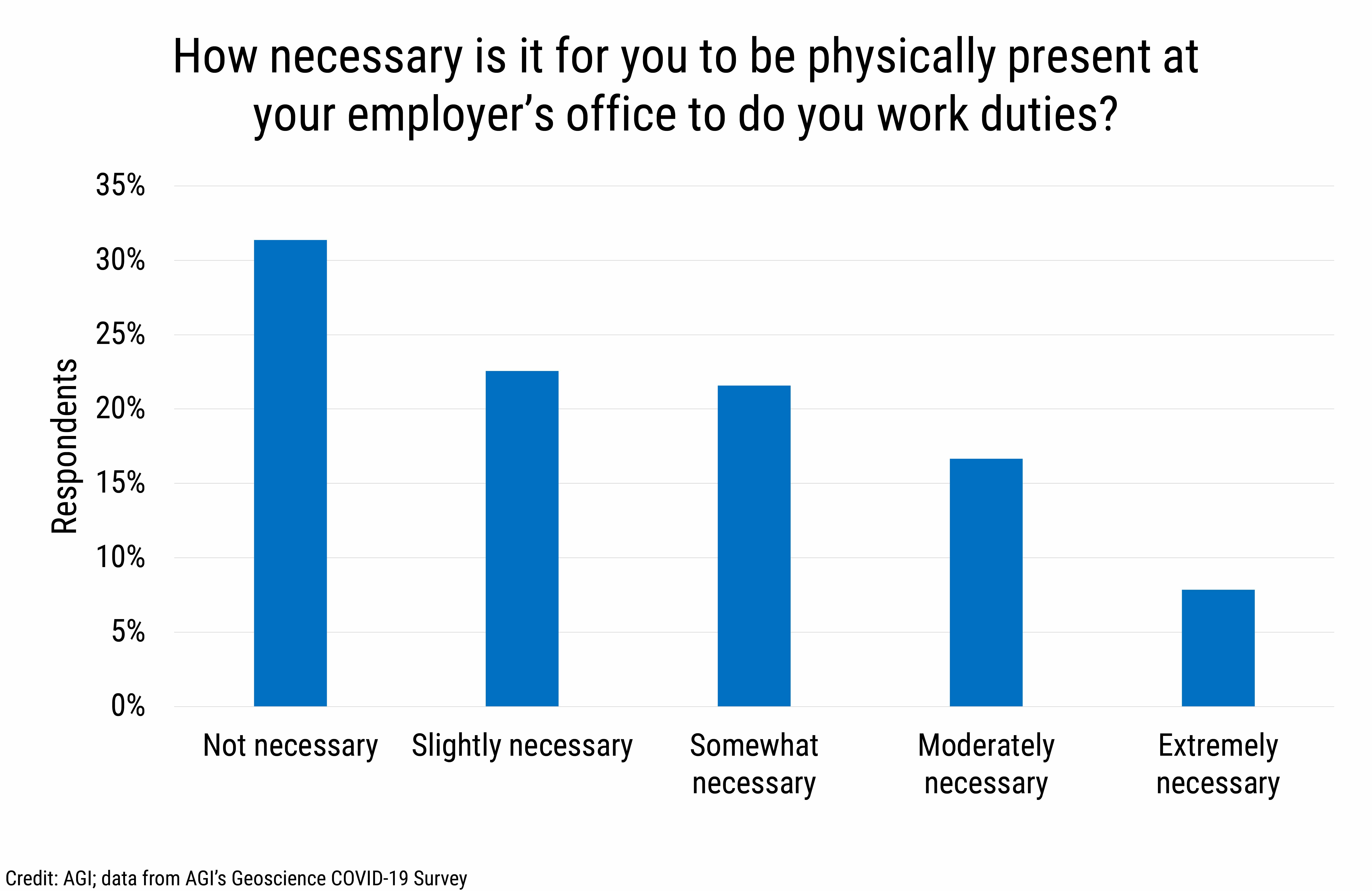
DB_2020-031 chart14 Physical presence at the office (Credit: AGI; data from AGI's Geoscience COVID-19 Survey)
AGI
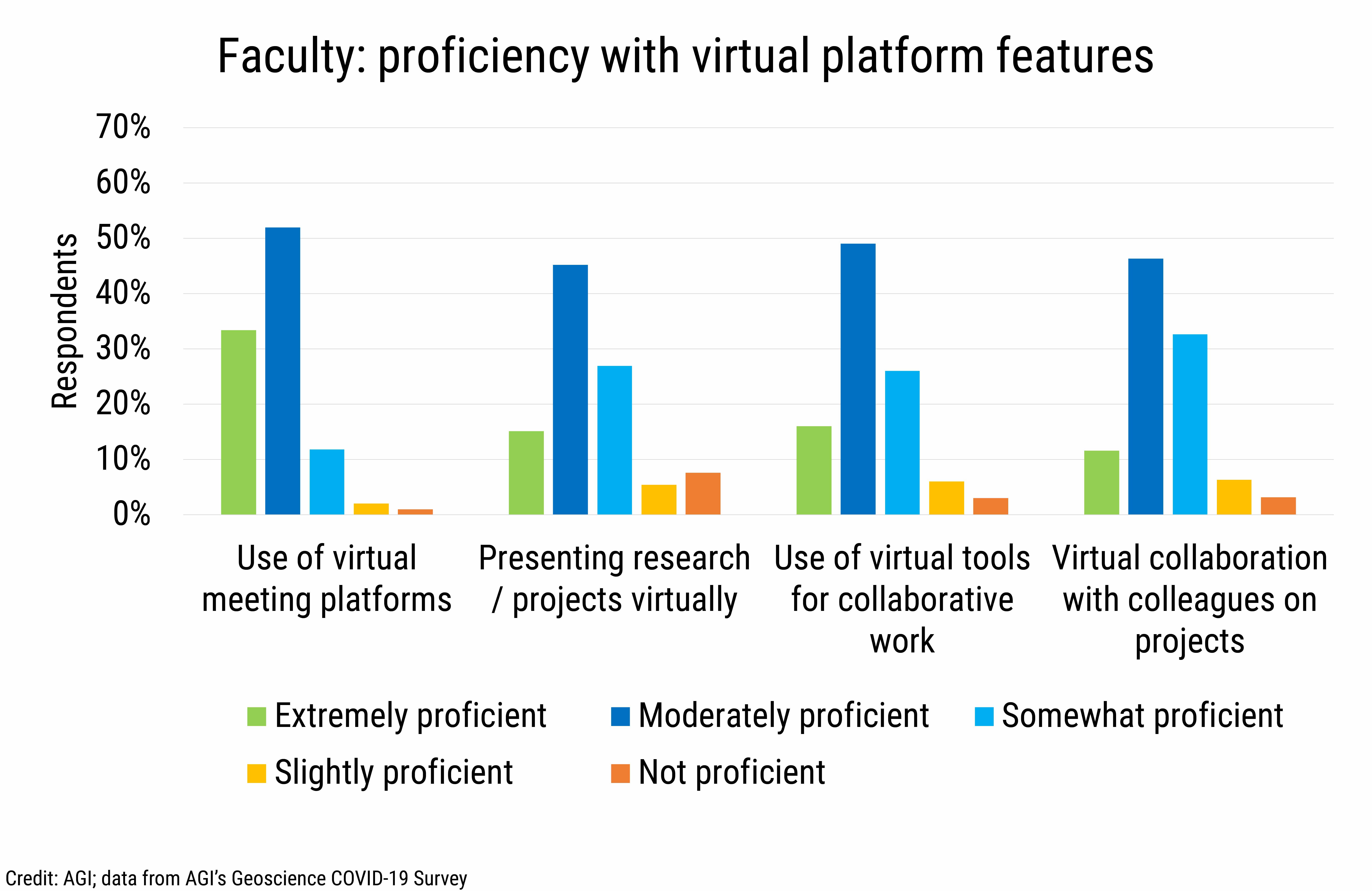
DB_2020-031 chart15 Faculty proficiency with virtual platform features (Credit: AGI; data from AGI's Geoscience COVID-19 Survey)
AGI

DB_2020-031 chart16 Students proficiency with virtual platform features (Credit: AGI; data from AGI's Geoscience COVID-19 Survey)
AGI
We will continue to provide current snapshots on the impacts of COVID-19
on the geoscience enterprise throughout the year. For more information,
and to participate in the study, please visit:
www.americangeosciences.org/workforce/covid19
Funding for this project is provided by the National Science Foundation
(Award #2029570). The results and interpretation of the survey are the
views of the American Geosciences Institute and not those of the
National Science Foundation.